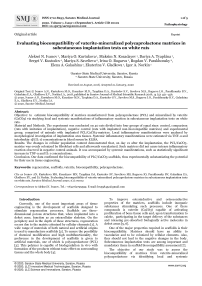Evaluating biocompatibility of vaterite-mineralized polycaprolactone matrices in subcutaneous implantation tests on white rats
Автор: Aleksei N. Ivanov, Mariya O. Kurtukova, Maksim N. Kozadayev, Dariya A. Tyapkina, Sergei V. Kustodov, Mariya S. Savelieva, Irina O. Bugaeva, Bogdan V. Parakhonsky, Elena A. Galashina, Ekaterina V. Gladkova, Igor A. Norkin
Журнал: Saratov Medical Journal @sarmj
Статья в выпуске: 1 Vol.1, 2020 года.
Бесплатный доступ
Objective: to estimate biocompatibility of matrices manufactured from polycaprolactone (PCL) and mineralized by vaterite (CaCO3) via studying local and systemic manifestations of inflammatory reaction in subcutaneous implantation tests on white rats. Material and Methods. The experiment was conducted on 40 rats divided into four groups of equal sizes: control, comparison (rats with imitation of implantation), negative control (rats with implanted non-biocompatible matrices) and experimental group, comprised of animals with implanted PCL/CaCO3-matrices. Local inflammatory manifestations were analyzed by morphological investigation of implantation area tissues. Systemic inflammatory manifestations were estimated via TNF-α and interleukin-1β (IL-1) concentrations in blood serum by ELISA. Results. The changes in cellular population content demonstrated that, on day 21 after the implantation, the PCL/CaCO3-matrice was evenly colonized by fibroblast cells and afterwards vascularized. Such matrices did not cause intense inflammatory reaction observed in negative control animals. It was accompanied by systemic manifestations, such as statistically significant increase in TNF-α and IL-1 concentrations. Conclusion. Our data confirmed the biocompatibility of PLC/CaCO3-scaffolds, thus experimentally substantiating the potential for their use in tissue engineering.
Regeneration, scaffolds, vaterite, biocompatibility, polycaprolactone
Короткий адрес: https://sciup.org/149135006
IDR: 149135006 | DOI: 10.15275/sarmj.2020.0102
Список литературы Evaluating biocompatibility of vaterite-mineralized polycaprolactone matrices in subcutaneous implantation tests on white rats
- Do AV, Khorsand B, Geary SM, et al. 3D Printing of Scaffolds for Tissue Regeneration Applications. Adv Healthcare Mater 2015; 4: 1742-62.
- Ivanov AN, Norkin IA, Puchinyan DM. The possibilities and perspectives of using scaffold technology for bone regeneration. Tsitologiya 2014; 56(8): 543-8. https://www.semanticscholar.org/paper/%5BThe-possibilities-and-perspectives-of-using-for-Ivanov Norkin/f41b6d46cec870dae2b0757588dfdc56b83534b3
- Novochadov VV. The Problem of cell settling and remodeling of tissue-engineered matrices for regeneration of the articular cartilage. Bulletin of Volgograd State University 2013; 1(5): 19-28.
- Mkhabela V, Ray SS. Biodegradation and bioresorption of poly (e-caprolactone) nanocomposite scaffolds. International Journal of Biological Macromolecules 2015; 79: 186-92. http://dx.doi.org/10.1016/j.ijbiomac.2015.04.056
- Saveleva MS, Ivanov AN, Kurtukova MO, et al. Hybrid PCL/CaCO3 scaffolds with capabilities of carrying biologically active molecules: synthesis, loading and in vivo applications. Materials Science & Engineering C-Materials for Biological Applications 2018; 85: 57-67.
- El-Fiqi A, Kim JH, Kim HW. Osteoinductive fibrous scaffolds of biopolymer / mesoporous bioactive glass nanocarriers with excellent bioactivity and long-term delivery of osteogenic drug. ACS Appl Mater Interfaces 2015; 7 (2): 1140-52.
- Ivanov AN, Kozadaev MN, Puchinyan DM, et al. Microcirculatory changes during stimulation of tissue regeneration by scaffold based on the polycaprolactone. Regional Blood Circulation and Microcirculation 2015; 14(54): 70-5. https://doi.org/10.24884/1682-6655-2015-14-2-70-75
- Ivanov AN, Kozadaev MN, Belova SV, et al. Comparative analysis of perfusion and dynamics of acute-phase markers of inflammatory response after polycaprolactone hydroxyapatite matrix implantation. Modern Problems of Science and Education 2016; 4: 15. https://science-education.ru/en/article/view?id=248211
- Norkin IA, Ivanov AN, Kurtukova MO, et al. Peculiarities of microcirculatory reactions after implantation subcutaneous polycaprolactone matrices, mineralized vaterite. Saratov Journal of Medical Scientific Research 2018; 14(1): 35-41. https://cyberleninka.ru/article/n/osobennosti-mikrotsirkulyatornyh-reaktsiy-pri-subkutannoy-implantatsii-polikaprolaktonovyh-matrits-mineralizovannyh-vateritom
- Ivanov AN, Kozadaev MN, Bogomolova NV, et al. The study of the biocompatibility of the matrix based on polycaprolactone and hydroxyapatite in vivo. Tsitologiya 2015; 57(4): 286-93.
- Bang LT, Ramesh S, Purbolaksono J, et al. Development of a bone substitute material based on alpha-tricalcium phosphate scaffold coated with carbonate apatite / poly-epsilon-caprolactone. Biomed Mater 2015; 10(4): 045011. http://dx.doi.org/10.1088/1748-6041/10/4/045011
- Nyberg E, Rindone A, Dorafshar A, et al. Comparison of 3D-Printed Poly-ɛ-Caprolactone Scaffolds Functionalized with Tricalcium Phosphate, Hydroxyapatite, Bio-Oss, or Decellularized Bone Matrix. Tissue Eng Part A 2017; 23(11-12): 503-14. https://doi.org/10.1007/7651_2017_37
- Thuaksuban N, Pannak R, Boonyaphiphat P, et al. In vivo biocompatibility and degradation of novel Polycaprolactone-Biphasic Calcium phosphate scaffolds used as a bone substitute. Biomed Mater Eng 2018; 29(2): 253-67. http://dx.doi.org/10.3233/BME-171727
- Zomorodian A, Garcia MP, Moura E, et al. Biofunctional composite coating architectures based on polycaprolactone and nanohydroxyapatite for controlled corrosion activity and enhanced biocompatibility of magnesium AZ31 alloy. Mater Sci Eng C Mater Biol App. 2015; 48: 434-43.
- Schroder R, Pohlit H, Schuler T, et al. Transformation of vaterite nanoparticles to hydroxycarbonate apatite in a hydrogel scaffold: relevance to bone formation. Journal of Materials Chemistry B 2015; 3: 7079-89. https://pubs.rsc.org/en/Content/ArticleLanding/2015/TB/C5TB01032B#!divAbstract
- Olah L, Borbas L. Properties of calcium carbonate-containing composite scaffolds. Acta Bioeng Biomech 2008; 10(1): 61-6. https://pubmed.ncbi.nlm.nih.gov/18634355/


